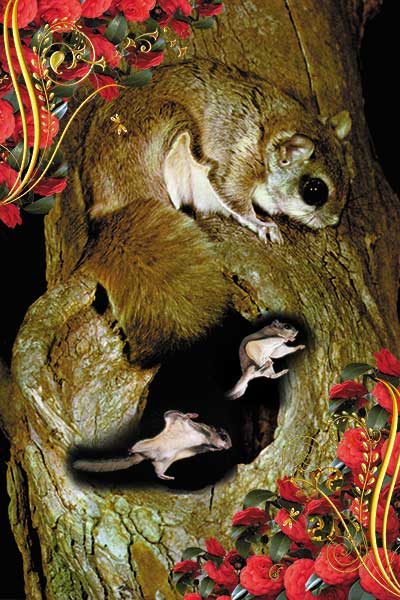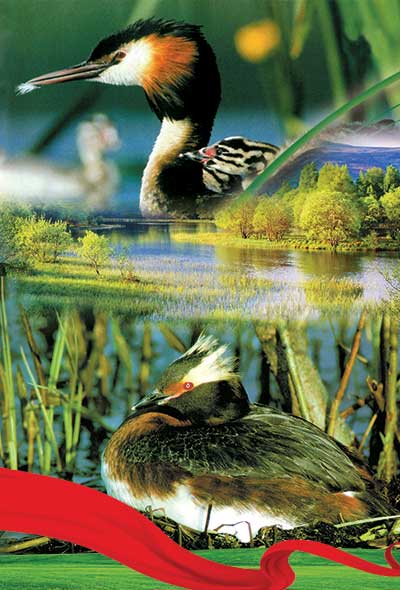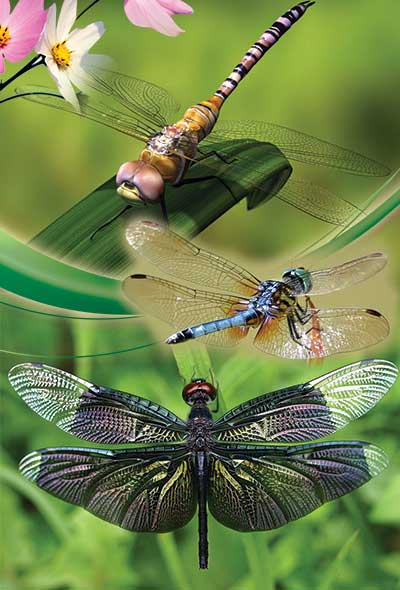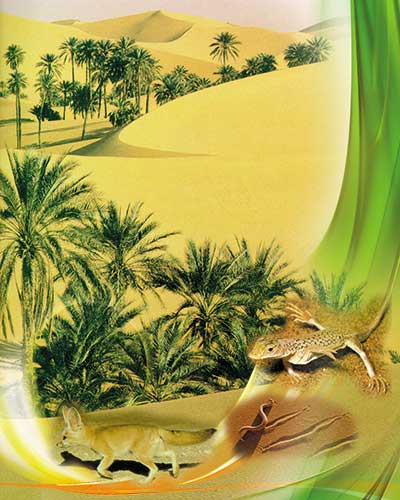 |
Allah introduces Himself through the creatures that have the special features He creates. The details people learn about the creatures they are familiar with increase their amazement. Also, the knowledge they gain about unfamiliar creatures enables them to raise the curtain of heedlessness existing in their minds. Even reflecting upon these features is a way of seeing the perfect creation in each of them and appreciating the endless might of Allah.
Flying squirrels, as well, are one of the millions of creatures bearing features that can alter one's monotonous thinking habits. These squirrels are found in Australia and they range in length from 45 cm to 90 cm (1.5 feet to 3 feet). All these creatures that can fly from one tree to another like gliders live in the trees. In order to fly like this, these creatures use a flight membrane present under their arms.
The gliding membrane of sugar-gliders stretches from their wrists to their ankles. It is narrow and has long, tassel-like hairs. In other kinds of flying squirrels, this parachute-like structure occurs in the form of a membrane that consists of furry skin. The animals fly off from the trunk of a tree and, with the effect of the wing-like gliding surface, can cross a distance of 30 meters (98 feet) in one go. The bigger flying squirrels move from tree to tree like gliders. These creatures have been observed traveling a distance of 530 meters (1,740 feet) in just six consecutive leaps.34
As has been seen in other examples given in this book, flying squirrels have features exclusive to themselves. When one ponders how the matchless characteristics that millions of species on Earth possess have come into being, one will immediately understand that not even one of them can have come into existence through random events and that a creature cannot acquire perfect features on its own or by chance. Allah created all animals, plants and human beings in a complete way. This is an obvious fact for those who ponder with wisdom and conscience.
Understanding this fact and conducting one's life accordingly is a behavior which is beneficial to one's self because the duty of man in the world is to see the magnificent creation of Allah and to praise, before this creation, the endless power and knowledge of Allah.
Your god is Allah alone, there is no god but Him. He encompasses all things in His knowledge. (Surah Ta Ha:98)
 |
What might be expected from an animal that has no consciousness is its leaving its offspring after giving birth. However, on the contrary, animals take all the responsibilities for their offspring to such an extent that they don't neglect measures that could protect their broods from dangers they might face in the future.
One of the best examples of this is the grebe, a species of water bird. Grebes carry their offspring on their backs and, for this reason, the parents become a kind of floating nest for their offspring. The newly hatched youngsters climb onto the back of the father or mother. The mother slowly raises her wings so that her offspring will not fall off and feeds them with morsels she holds in her beak, reaching her head out to one side.
However what grebes give to their offspring first is not actual food. Grebes first make their offspring eat feathers that they either collect from the surface of the water or pluck from their breasts. Each chick swallows a large number of feathers. Well, what might be the reason for this interesting diet?
The feathers the chicks eat are not fully digested but rather gathered in their stomachs. Some of them form a felted plug at the point where the stomach leads to the intestine. Fish bones and indigestible parts of other foods accumulate here. Thus, sharp fish bones or hard parts of insects are prevented from passing through the stomach and doing harm to the delicate walls of the intestines. This experience of eating feathers will continue throughout the bird's life. However, the first feathers it is fed are an important precautionary measure for its very health.35
It is possible to see in all creatures behavior like that of the grebes, actions aimed at meeting the needs of the offspring and protecting them in every way. Every creature on Earth assumes every kind of responsibility for their offspring until they reach sufficient maturity to meet their own needs.
This kind of behavior seen among creatures in nature nullifies the evolutionists' claims that "nature is an arena for battle and the survival of the fittest." It is obvious that the origin of this kind of behavior in creatures cannot be in their intelligence and that a bird, tiger or any other animal cannot act according to the needs of other animals, taking delicate details into consideration. These creatures behave by the inspiration of Allah. Allah inspires every creature in its behavior and they conform to this perfectly. Every one of them obeys Allah who has created them. This fact is stated in the Qur'an as follows:
Everyone in the heavens and earth belongs to Him. All are submissive to Him. (Surat ar-Rum: 26)
 |
The dragonfly has a flawless flying capacity, so much so that it can stop suddenly and begin to fly in the opposite direction at whatever speed or in whatever direction it chooses. Moreover, it can hang in the air in a suitable position to attack its prey. In addition, it can head towards its prey, making agile turns to do so. These are only some of the maneuvering skills of the dragonfly that have provided inspiration for helicopters, the products of today's advanced technology.
The body of the dragonfly has a helical structure wrapped with a metal covering. The dragonfly, which can have various colors, from ice blue to maroon, has two pairs of wings on its back, one pair in front and the other pair to the rear. The wings work in a coordinated way. In other words, as the two front wings rise, the two wings at the rear descend. The movement of the wings is accomplished by the movements of two opposite groups of muscles. One end of the muscles is attached to extensions in the body in the shape of a lever. While one group of muscles contracts and causes a pair of wings to rise, the other group of muscles loosens to the same degree and causes the second pair of wings to fall. In fact, helicopters that are produced using dragonflies as their model descend and ascend using the same principle.
The perfect flight of dragonflies is realized by these four large independent wings carrying its body's weight. This feature enables the insect to make sudden maneuvers, increase its speed and fly at a speed that reaches 10 meters (33 feet) per second.36
The sight capacity of the dragonfly, which can make sudden maneuvers at very high speeds, is also perfect. The eye of the dragonfly is considered, in scientific circles, as the finest insect eye in the world. Each of its eyes contains 30,000 individual lenses. The eyes look like two hemispheres covering half of its head, and they provide a very broad field of vision for the insect. With these extraordinary eyes, the dragonfly can almost see what's happening behind its back.37
As shown above, the dragonfly has a perfectly structured individual system. The slightest deficiency in any one part of these systems will cause the other systems to become useless. However, all the systems have been created perfectly and the creature survives by means of this. The unique design in the dragonfly belongs to Allah. He has the knowledge of all creation.
 |
Extreme heat in the daytime, freezing cold at night, droughts lasting for weeks or even months on end, scarcity of food… All this is part of the environment of deserts. It is very difficult to survive under such harsh conditions. However, in spite of all these hardships, there are many creatures that survive and even thrive in the deserts. When we look at these creatures, we see that all their movements and body structures have been created with the characteristics that are appropriate for living there. Allah protects these creatures from heat with unique features He created. When we take a close look at some characteristic examples, we clearly see that the attributes of these creatures couldn't have come into existence by chance, but instead were created by a Creator Who has a superior power.
Sand vipers (Cerastes Vipera) live under the sand. The viper dives into the sand with a sideways wiggle. It moves its tail from left to right very quickly and then this movement covers the whole body, consisting of three twists, until has the snake buried itself completely, save perhaps one or both of its eyes. This way, the viper lies in wait and so hunts for its prey. But such a strategy runs the risk of the snake's eyes suffering harm, since they are kept outside in a place where sandstorms may suddenly whip up. However, because of the design of the viper's eyes, this risk is completely eliminated. The eye of the viper is protected against the irritating effects of the sand with an outer "spectacle" made up of a transparent scale.38
The cream-colored fennec fox, the smallest of the foxes, another desert denizen, has very large ears. These foxes live in the sandy deserts of Africa and Arabia. Its wide ears not only help to determine the location of its prey but also serve to prevent excessive heating and enable the animal to stay cool.39
The shovel-snouted lizard, which lives in the desert, moves as if dancing on the sand in order to cool its tail and legs. Then, taking support from its tail, it transversely lifts one front and one back foot. After a couple of seconds, the feet switch positions. The lizard almost swims on sand hills by means of its aerodynamically shaped nose and body, and its large feet enable it to run on the sand very rapidly.40
The desert frog, which lives in Australia, is like a water tank. When it rains, the frog fills the pouches in its body with water. Then it buries itself under the sand and begins to wait for the coming rains. When they become thirsty, other desert animals find these animals and drink water from them, taking them out of the sand.41
34-Bates Hayvanlar Ansiklopedisi (Bates Encyclopedia of Animals), C.B.P.C. Publishing Ltd., p.88.
35- CDavid Attenborough, The Life of Birds, Princeton University Press, New Jersey, 1998, p.256.
36- DScience et Vie, no.931, p.5
37- http://www.cs.tut.fi/~hirvone2/Dragonfly.html
38- Evolution Encyclopedia, Vol. 2, http://evolution-facts.org/2evlch20.htm
39- Michael Scott, The Young Oxford Book of Ecology, Oxford University Press, Oxford, 1994, p. 49.
40- International Wildlife, November-December 1997, no.6, p.53.
41-Maurice and Robert Burton, Encyclopedia of Reptiles, Amphibians and Other Cold Blooded Animals, Octopus Books Limited, 1975, p. 48